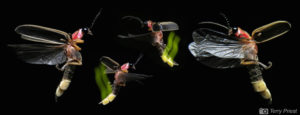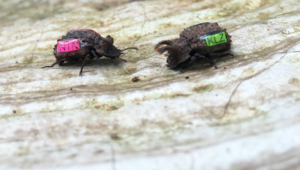Tuesday February 13th
MCZ 101, 26 Oxford Street, Harvard University
07:30 PM
Fireflies: Bright Lights & Bling
Sara Lewis
Tufts University

With over 2,000 species worldwide, the firefly beetles (family Lampyridae) boast remarkable diversity in life history and signalling modes. Their bioluminescent courtship is based on highly visible signals that are readily quantified and simulated, providing an attractive system for dissecting the key evolutionary process of sexual selection. Studies of North American Photinus fireflies over the past decades have revealed that male mating success is determined primarily by female preference for conspicuous male flash traits. Yet sexual selection continues even beyond mating. During copulation, males transfer complex spermatophores that they manufacture within multiple reproductive accessory glands. Such nuptial gifts are widespread across the animal kingdom, though we are just beginning to unravel the biochemical composition and evolutionary trajectories of these cryptic sexually selected traits.
Meanwhile, these charismatic insects seem to be declining in many parts of the world. Among the major culprits are habitat loss, light pollution, overharvesting, and ecotourism. Here in the Anthropocene, bioluminescent talents can be hazardous to your health! Come hear little-known stories about how, for more than a century and continuing to the present day, fireflies have been exploited for their chemistry, beauty, and romance.
Fireflies are intricately woven into the fabric of human cultures, and their loss would be widely mourned. From a scientific perspective, we remain in the dark about many features of firefly biochemistry, behavior and evolution. In hopes of inspiring further inquiry, this talk will conclude by highlighting some fascinating, outstanding questions in firefly biology.
The talk is free and open to the public. The meeting is readily accessible via public transportation. Parking is available in the Oxford Street Garage with advance arrangement, as described here, or (usually but not always) at spaces on nearby streets. Everyone is also welcome to join us for dinner before the talk (beginning at 5:45 PM) at the Cambridge Common, 1667 Mass Ave., Cambridge.
CEC meetings are held the second Tuesday of the month from October through May. The evening schedule typically includes an informal dinner (5:45 to 7:15 PM) followed by our formal meeting (7:30 – 9:00 PM). The latter begins with club business and is followed by a 50 minute entomology related presentation. Membership is open to amateur and professional entomologists.
 “All of life is social.” This quote by biologist Steven Frank drives home a simple fact about all living organisms: At some point in their lives they interact with members of their own species and those interactions have consequences for their success and ultimately the population’s evolution.
“All of life is social.” This quote by biologist Steven Frank drives home a simple fact about all living organisms: At some point in their lives they interact with members of their own species and those interactions have consequences for their success and ultimately the population’s evolution. The talk is free and open to the public. The meeting is readily accessible via public transportation. Parking is available in the Oxford Street Garage with advance arrangement, as described
The talk is free and open to the public. The meeting is readily accessible via public transportation. Parking is available in the Oxford Street Garage with advance arrangement, as described 

